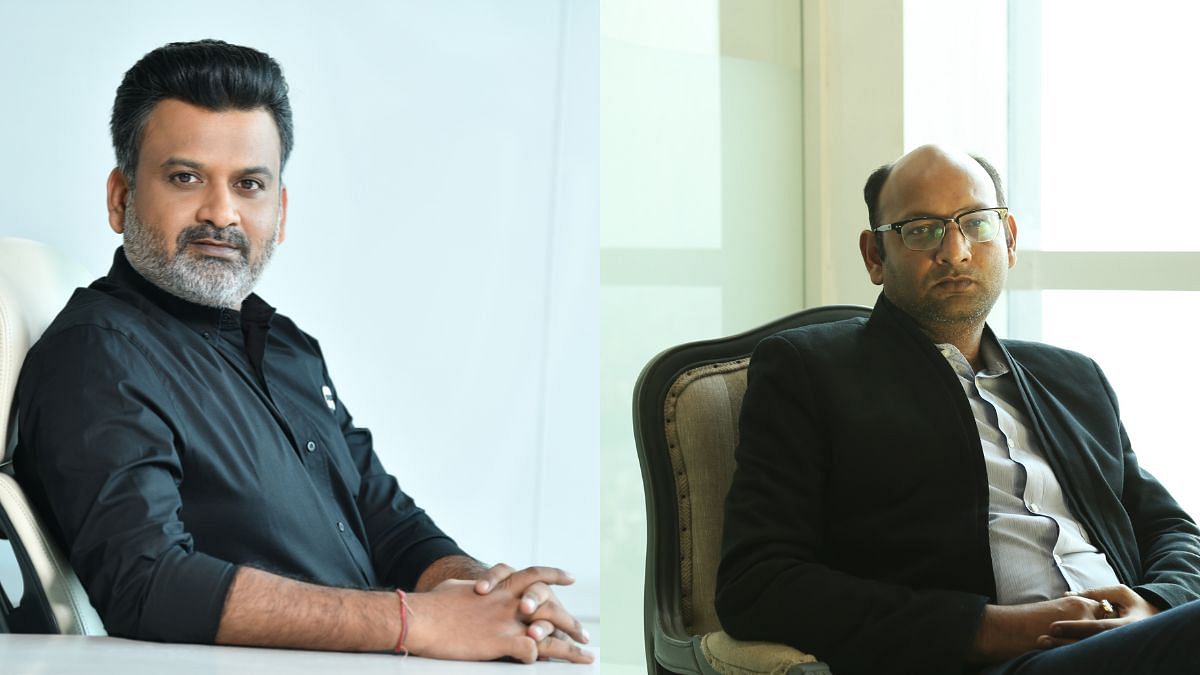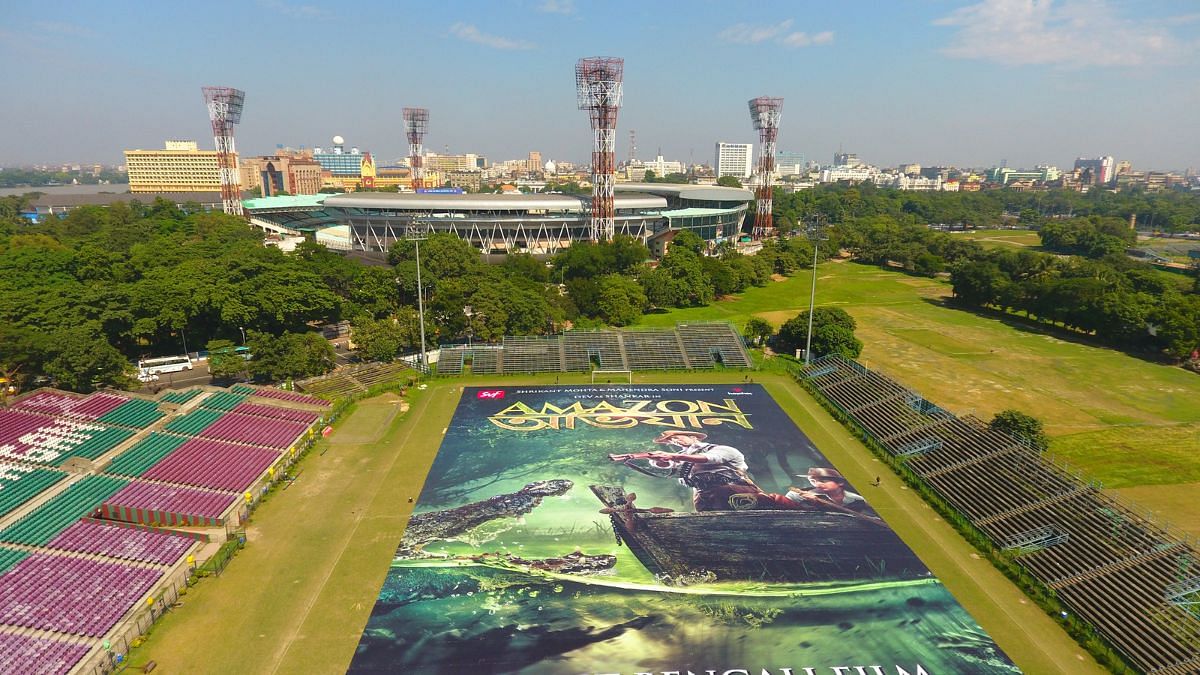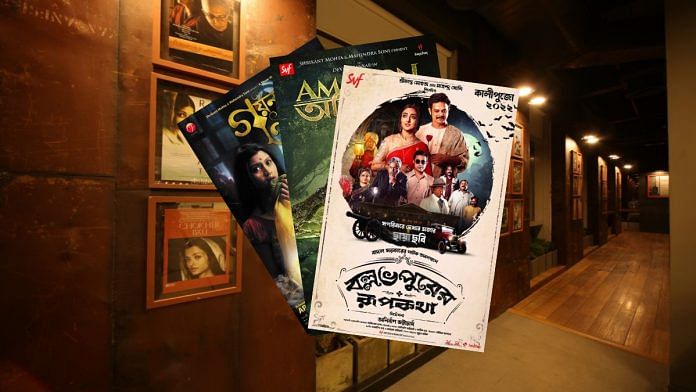Kolkata: Shree Venkatesh Films is having its moment as the biggest production company in eastern India. But back in the 1990s, it had been rejected by the very entertainment behemoth it is now being compared with. “We were talking with Yash Raj Films for the distribution rights of Dilwale Dulhaniya Le Jaenge. In the end, the deal was cancelled. We were really hurt,” said Mahendra Soni, co-founder of the Bengali production house. The rejection now sits like a trophy as they run a formidable empire called SVF—the YRF of West Bengal.
The experience pushed them to make their own films rather than just being a vehicle for other people’s creativity. From producing national award-winning films like Chokher Bali (2003) and Ek Je Chhilo Raja (2018) to churning out remakes of South Indian hits like Josh (2010), a remake of the 2005 Telugu film Bhadra, SVF has its hands in multiple pots, setting trends and directing the flow of entertainment in West Bengal and Assam.
The brainchild of two 20-year-old cousins from Howrah, Mahendra Soni and Shrikant Mohta, SVF, has completed nearly three decades in the film industry. This year, it tied up with Jio Cinema. Soni said this will allow them to make bigger “pan-Indian” blockbusters.
But their climb to the top of the game is interspersed with failures. It wasn’t just the rejection by YRF. Soni and Mohta suffered huge losses when Sanjay Leela Bhansali’s Khamoshi: The Musical (1996)—for which SVF had distribution rights—bombed at the box office. But for the cousins, these setbacks were stepping stones. They would bounce back each time with bigger, bolder and better ideas.
Four years after the Khamoshi debacle, SVF had perfected the art of making a commercial success. It rolled out its blockbuster, Sasurbari Zindabad (2000) to record-breaking revenues. With themes similar to the 1996 Hindi hit Raja Hindustani, it became the first Bengali film to cross the Rs 2 crore mark. It created shockwaves with an infamous 30-second liplock between its two stars, Rituparna Sengupta and Prosenjit Chatterjee. Twenty-three years later, the film’s song, Chokh Tule Dekho Na, is still a staple during Durga Pujo celebrations in Kolkata.
Today, SVF has built a roadmap for other regional OTT platforms with Hoichoi. Launched in 2016, it was the first, and now the biggest, regional OTT platform.
“SVF brought with it bigger budgets, foreign locations and better costumes. But being in the business of movies meant that not all their films were artistically great even if they worked commercially,” said a Bengali director, under the condition of anonymity.
Also read: Bengali cinema has an addiction problem—Now, Byomkesh, Feluda detective-verse about to expand
Side hustle to empire
SVF’s 17th-floor office in Acropolis Mall at Kolkata is a shrine to cinema and creativity. The meeting rooms are named after Bengali film stalwarts like Ritwik Ghatak, as well as world cinema giants like Christopher Nolan. A long corridor leads to a room dedicated to the late Rituparno Ghosh. A glass case outside displays a jacket of the National Award-winning filmmaker. Rows and rows of film posters occupy every wall.
It’s a museum-cum-production house all rolled into one, a far cry from its early years when SVF was a tiny room run by two fresh-out-of-college youngsters still green behind the ears. Both cousins came from traditional business families where entertainment was more an aside than the mainstay.

“We had a family business of making rakhis, which is mostly seasonal. It was Shrikant’s father who had a side business of film distribution that he asked us to look into,” said Soni.
This was in the early 1990s, and the two decided to immerse themselves in the business of cinema. Their lack of knowledge and experience was compensated by an appetite to constantly expand and evolve. It remains their philosophy and business strategy even today.
SVF produced its first film, Bhai Amar Bhai, starring Prosenjit Chatterjee, in 1996. It was the start of a long relationship with the actor. The ensemble cast film also included Bengali actors Abhijeet Chatterjee and Chiranjeet.
But after the film’s first screening, the duo became worried about having lost their uncle’s side business forever.
“Shrikant and I came out [the viewing] and realised mamaji (Shrikant’s father) will kill us,” said Soni. But the distributors who watched the film thought otherwise. They began proclaiming 100-day screenings for it, which turned out to be prophetic.
Once they had a commercial hit and understood how to replicate it, they wanted to create a footprint in more arthouse cinema that Bengal is known for. This is when the brilliant Rituparno Ghosh came into the picture.
“Ghosh wanted to make a film [Chokher Bali] that was the response to Bhansali’s opulent Devdas. He wanted to show that grandeur can be brought to the screen without a massive budget, ” said Soni. Initially, SVF was not keen on making the film. Its budget alone was Rs. 2.5 crore—unheard of in Bengali cinema. Soni and Mohta started avoiding Ghosh’s calls.
“It was I who finally convinced Shrikant da and Mohen da to finance Chokher Bali,” said Prosenjit, who played the lead role, Mahindra. Based on Rabindranath Tagore’s novel of the same name, the film explores heart-wrenching themes of family dynamics and extra-marital affairs, catapulting SVF onto the national stage. Apart from Prosenjit, it starred Aishwarya Rai Bachchan, Tota Roy Chowdhury and Raima Sen in the lead roles.
Chokher Bali won three National Film Awards — Best Feature Film in Bengali, best costume design and best art direction. It marked the start of a long association between Ghosh and SVF, which resulted in memorable films like Raincoat (2004) and Memories in March (2010), among others.
Also read: Gadar, Pokiri, DDLJ — old hit movies back in theatres. Nostalgia trumps new releases
Pushing boundaries
The cousins were not afraid to push the boundaries of what Bengali films should look like. They turned their back on traditional domestic dramas and embraced a medley of genres from crime to commercial potboilers to thought-provoking cinema. They experimented with shape-shifting snakes in Nag Naagini (1998) and reimagined Indiana Jones as a Bengali treasure hunter and explorer in Chander Pahar (2013) and Amazon Obhijaan (2017). Both films are based on the fictional character, Shankar, written by Bengali novelist Bibhutibhushan Bandyopadhyay. The movies ruled the box office when released and remain among the top 10 highest-grossing Bengali films in the last decade.

Every new and successful character spawned a sequel, if not a trilogy. Another crowd-pleaser was treasure hunter Sona Da from the Guptodhon series, a Bengali version of the Nicolas Cage-starrer National Treasure.
In 2020, SVF released Dwitiyo Purush, a sequel to its cult serial killer thriller, Baishe Srabon (2011). Dwitiyo ran for 109 days and earned over Rs 3 crore at the box office.
By the early 2000s, SVF decided to become ‘king makers’ by launching new talent. It was another step in cementing its grip on the Bengali film industry.
It launched Bengali superstar Jeet with the film Sathi (2002) when he was 24. With every subsequent film, Jeet cemented his stardom and fanbase, defying predictions that there would be no big star after the death of yesteryear icon Uttam Kumar.
Now, they have an entire wing for new talent management. Its stable of celebrities includes Shruti Das, who made her big screen debut with Srijit Mukjherjee’s X=Prem (2022). She won the best female debut actor, along with Piyali Samanta, in Joy Filmfare Awards Bangla 2023. Shruti, who played Joyee, a computer engineer, is also part of Hoichoi’s upcoming ambitious project, Shri Swapankumar-er Badami Hyena’r Kobole, slated to be released during Kali Pujo this year.
Older stars, too, have started turning to SVF to revive their fame, and fortunes. Anirban Bhattacharya, better known for playing Byomkesh Bakshi, and the villain Khoka in Dwitiyo Purush as well as Abir Chatterjee, who has played Feluda, count on SVF’s support.
Directors like Srijit, who earned plaudits for his Bengali and Hindi films like Sherdil: The Pilibhit Saga (2022) and Jaatishwar (2014), have had a long-standing creative association with SVF.
Also read: India has no TV, OTT content for its nearly 50 crore GenZs. It’s still a millennial machine
SVF’s many projects
Over the years, SVF has spread its creative tentacles across platforms, from television to music to OTT.
“Yash Raj Films failed to take off on television. Everyone told us, we will fail too. But we didn’t,” said Soni.
Bollywood was not going to tell these two mavericks how to run their business—certainly not for television.
Since 2008, SVF has produced over 60 shows across popular Bengali channels like Star Jalsha, Zee Bangla and Colors Bangla. The popular soap Maa (2009) plumbed the depths of family drama with a staggering 1,508 episodes. Another hit series, Potol Kumar Gaanwala (2015), was about a prodigious young singer’s quest to reconcile with her estranged father.
It was adapted into a Hindi serial, Kulfi Kumar Bajewala, in 2018.
SVF also produced the Bengali magnum opus Mahanayak, a 112-episode tribute to Uttam Kumar, which premiered on 27 June 2016 on Star Jalsha.
In October 2021, SVF collaborated with the short video app Josh to create more opportunities for Eastern Indian content and creators. The video app saw an increase of 62 per cent in user base since its collaboration with SVF, according to a Live Mint report.
SVF Music’s new initiative is to provide a platform and promote independent musicians through a new IP titled ‘Banglar Gaan (Indies)’.
It’s been six years since SVF launched one of India’s first regional language OTT platforms, Hoichoi. It quickly began garnering both subscription and loyal viewers across the Bengali-speaking audience, not just within the state and country, but in neighbouring Bangladesh and the diaspora in London, New York and Hong Kong. Its target audience is not simply ‘regional’; SVF’s content is targeted at the 228 million Bengali speakers spread across the globe.
SVF defies attempts to typecast its content—highbrow and lowbrow, fantasy and family drama, all have a home at Hoichoi. Its recent web series, Noshtoneer, which tackles consent and abuse of power in a university space, has been lauded for its portrayal of the sensitive themes.
“For Hoichoi, we have divided our content into two parts, one is driven by the female-centric protagonists, and the other is crime,” said Mohta. Its shows like Indubala Bhaater Hotel (2023), a female-driven social drama, are as popular as its many detective shows. Its target audience is the educated, smart and driven Bengali woman, who craves content beyond the usual fare on television and films.
From curating the only digital library of Bengali films to creating socially aware content on sexual harassment, the platform aims to be a one-stop shop for entertainment.
Taking a chance on Bengal
The two cousins built an empire by cracking the code of success at a time when no one paid attention to the Bengali film industry. They discovered that Hindi films were restricted to Kolkata, Siliguri, Asansol, and other big cities in West Bengal. In the suburbs and smaller towns, Bengali films reigned supreme.
Only 50 cinema halls screened Hindi films back in the 1990s. But Bengali cinema screeched to a halt with the death of Uttam Kumar in 1980. Commercially successful Bengali films had almost dried up. For Mohta and Soni, it was a eureka moment. Why not produce Bengali films and distribute them?
The ups and downs they went through while courting Bollywood for distribution rights cemented their resolve. When they were starting out, they won distribution rights for two Hindi films, Dosti Ki Saugandh (1993) and Ikke Pe Ikka (1994). And then came their big break — Mani Ratnam’s Bombay (1995). Even though no one else believed the film would be a hit, Soni and Mohta were convinced otherwise.
“First, it was a dubbed film where no one knew who the actor was. The only selling point was Manisha Koirala,” Soni recalled. Bombay proved to be a massive commercial hit, giving them enough confidence to invest in what they thought was the ‘next big thing’.
“We thought we had arrived. So we bought what we thought would be an even bigger hit, Sanjay Leela Bhansali’s Khamoshi,” he said. Except, it bombed, and the duo lost more money than they made with Bombay.
After the dance of uncertainty in distribution, Soni and Mohta were determined to create a hit. While producing their first film, Bhai Amar Bhai (1996), they left nothing to chance. They arrived before everyone else on film sets and sat for hours on end with editors. After all, they had invested an unheard-of sum in the Bengali film industry, Rs 70 lakh, into making the film. It paid off. It was the first Bengali film to touch the coveted Rs 1 crore mark at the box office.
Over the years, with accumulated experience, the two men have perfected a rhythm in their working partnership. Mahendra scales up the commercial aspect of the company — from creating multiple verticals to collaborating with other OTT platforms, like the Telugu streaming app Aha. Mohta is the creative honcho who takes calls on acquiring book rights or new talent.
Within the industry, SVF is hailed by many as a visionary—the only production company willing to invest in its ideas. But others resent their control and ability to dictate who becomes a star.

SVF has almost no competition, despite multiple actors establishing their own production companies.
The other prominent production house is Surinder Films, helmed by producer Nispal Singh. And while it has films like the critically acclaimed Prosenjit-starrer Jyeshthoputro (2019) and the period thriller Kaberi Antardhan (2023) under its belt, it cannot compete with SVF’s sheer scale and reach.
SVF wants everyone to watch its movies, and for the cousins, the best way to do that is to build multiplexes across West Bengal. Its latest multiplex in Malda has three screens, equipped with recliner seats and all the technology to take on the likes of PVR.
Opening multiplexes may go against the grain, but Mohta and Soni say otherwise. During the pandemic, single-screen cinema halls permanently downed shutters, leaving the non-Kolkata Bengali film-going audience bereft. SVF sees this as an opportunity to create revenue and get people back to halls. So far, it has opened 17 theatres in Bengal, and one in Assam.
If there is one thing that holds SVF back, it’s movie budgets. In West Bengal, most films don’t have a budget beyond Rs 1 crore, and shoots rarely exceed 20 days. SVF has solved this problem by signing a multi-film collaboration with Jio Cinemas.
“The Jio partnership will help us make bigger films and pan-India entertainers,” said Soni. The deal promises bigger films with talents like Mithun Chakraborty, Prosenjit, Jisshu Sengupta and the directors Anirban Bhattacharya, Dhrubo Banerjee, Raj Chakraborty, Srijit Mukherji and Suman Ghosh.
A side hustle run by two people is now a 200-strong empire which is training its attention on a fickle Gen Z that doesn’t put too much stock in any one brand or genre for an extended period of time.
“You cannot really tap into that audience. They do not like to commit to anything. They watch whatever they like, it can be a period drama, or it can be a detective show,” said Mohta.
The cousins haven’t cracked this puzzle—yet.
(Edited by Theres Sudeep)




